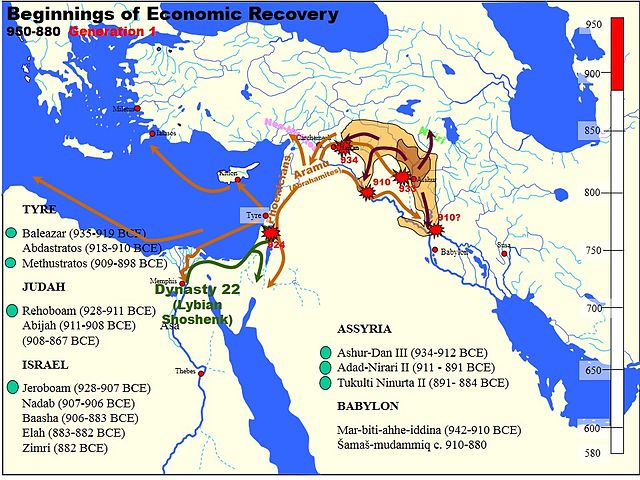The Neo-Assyrian Empire was the fourth and penultimate stage of ancient Assyrian history. Beginning with the accession of Adad-nirari II in 911 BC, the Neo-Assyrian Empire grew to dominate the ancient Near East throughout much of the 8th and 7th centuries BC, becoming the largest empire in history up to that point. Because of its geopolitical dominance and ideology based in world domination, the Neo-Assyrian Empire is by many researchers regarded to have been the first world empire in history. It influenced other empires of the ancient world culturally, administratively, and militarily, including the Babylonians, the Achaemenids, and the Seleucids. At its height, the empire was the strongest military power in the world and ruled over all of Mesopotamia, the Levant and Egypt, as well as parts of Anatolia, Arabia and modern-day Iran and Armenia.
Assyrian borders and campaigns under Ashur-dan II (r. 934–912 BC), Adad-nirari II (r. 911–891 BC) and Tukulti-Ninurta II (r. 890–884 BC)
Annals of Tukulti-Ninurta II (r. 890–884 BC), recounting one of his campaigns
Stele of Ashurnasirpal II (r. 883–859 BC)
Assyrian borders and campaigns under Ashurnasirpal II (r. 883–859 BC)
Assyria was a major ancient Mesopotamian civilization which existed as a city-state from the 21st century BC to the 14th century BC, then to a territorial state, and eventually an empire from the 14th century BC to the 7th century BC.
The head of a female statue, dating to the Akkadian period (c. 2334–2154 BC). Found at Assur, on display at the Pergamon Museum in Berlin
The ruins of the Old Assyrian trading colony at Kültepe
A partial relief of Tiglath-Pileser III, r. 745–727 BC, under whom the Neo-Assyrian Empire was consolidated, centralized and significantly expanded
Detail of a stele in the style of the Neo-Assyrian royal steles, erected in Assur in the 2nd century AD under Parthian rule, by the local ruler Rʻuth-Assor








